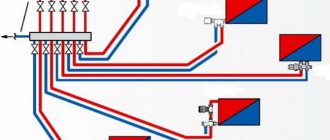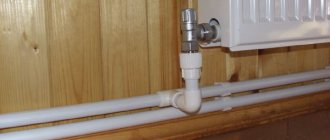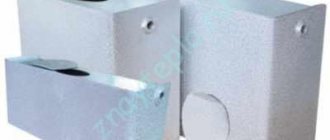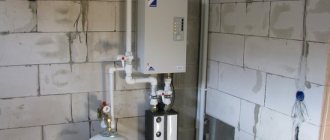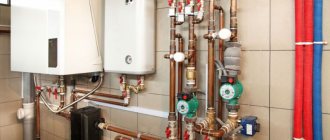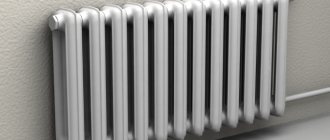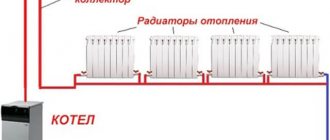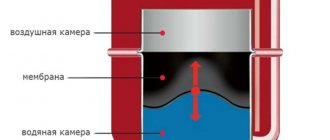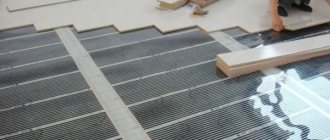Pipeline laying diagrams
This type of diagram characterizes the method of laying system pipelines depending on the method of connecting heating devices to them. There are 3 main schemes for laying pipes of a water heating complex:
- Single-pipe;
- Two-pipe;
- Collector-beam.
In a single-pipe scheme, radiators are connected to the supply pipeline in series - the coolant passes through each device in turn, from the last device the return pipeline returns cooled water to the boiler.
Here there is a gradual decrease in temperature from the first battery to the last on the line, so the length of the branches is limited - it is not recommended to place more than 4 - 5 radiators on one line. In addition, difficulties arise in temperature control - when the coolant flow is limited, the temperature on all radiators located behind the adjustable one decreases. You cannot disconnect the batteries either - in this case the circulation along the entire line will stop.
The single-pipe circuit has a modified version - the change is made by installing a bypass on each radiator - a jumper of equal or smaller diameter between the inlet and outlet of the coolant from the battery.
Through this bypass, part of the hot water bypasses the heating device and enters the next one, mixing with the return flow from the first one (on which the jumper is installed). This optimization somewhat equalizes the temperature on heating devices and makes it possible to partially regulate and turn off individual batteries.
The two-pipe scheme is more advanced from a technical point of view. In it, the radiators are connected in parallel to two independent pipelines - supply and return (return). This allows the batteries to operate with minimal mutual interference; the devices are easy to control and can be turned off for repair or cleaning.
The two-pipe system has 2 varieties - a tee (dead-end) scheme and a Tichelman loop (passing scheme). Most experts agree that the Tichelman passing system is more efficient in operation. You can read more about the two-pipe water heating scheme in a special article.
The collector (radial) circuit is implemented by connecting radiators with separate connections to distribution manifolds. When installing a system of this type, increased pipe consumption is observed. The advantage of this scheme is that the control of heating devices is concentrated in one place - on the collector unit. But in this case, difficulties may arise in laying pipelines - a massive bundle of pipes departs from the collector unit, which are difficult to hide, especially in the groove. In addition, when using a collector system, increased hydraulic resistance occurs - this may require the installation of a more efficient circulation pump.
Basic schemes are often combined with each other. For houses with 2 or more floors, a popular scheme is a system with 2 vertical risers. They are a two-pipe component of the circuit; either single-pipe floor-to-floor branches or floor-to-floor collector groups are connected to them.
A separate water heating scheme is a complex of heated floors. It includes a special unit and operates in low-temperature mode. The pipelines of the circuits are laid according to 2 main schemes - in rows (coil) and in a spiral (snail). You can read more about the installation of water heated floors here.
Heating circuits determined by piping
The difference between these heating systems lies in the principles of connecting heating devices to the boiler. This can be a serial or single-pipe connection, parallel or two-pipe and radial, or collector.
Sequential heating system
In a heating system with one pipe, the hot coolant enters all heating devices in order, releasing part of the heat in each. Such installation diagrams of heating systems are the simplest, and their implementation requires the least number of components and materials.
The main disadvantage of such a system is that the amount of heat released decreases depending on the distance from the boiler.
Heating diagram with two pipes
In this heating system, two pipes are connected to each heating device - with hot coolant, direct, and with cold coolant, return. The system has undoubted advantages, but they are “paid for” by a double set of pipes laid in the house.
Radiant heating system
This system differs from the others in that a separate pair of pipes is laid to each heating device - both direct and reverse current. They then converge near the boiler on special combs. The total length of the pipes is longer than in a two-pipe system.
No connections are made in these pipes and balancing is carried out before putting it into operation. That is, they adjust the coolant flow for each loop separately.
Such a system solves issues related to the regulation of heat transfer for each heating device in a system with one pipe. Each battery has a shut-off valve and with its help the coolant flow through it is regulated.
In addition, a shunt is made in the form of a bypass pipe with a smaller diameter. This shunt ensures fluid circulation even if the taps on the battery are completely closed.
Equipment options, how heat consumption is calculated and payment methods for services
In order to understand how much coolant you consume to heat a house with a large number of apartments, the best option would be to install a house meter. To calculate the payment for consumed heat, readings are taken from the meter. They are divided by the number of apartments in the building and their area. A house meter makes it possible to pay for heat only in the cold season and it is possible to reduce the amount of incoming energy into the heating systems of buildings.
House heat meter
This leads to you saving your finances when favorable living conditions arise. The cost of this type of heating is indicated by local authorities. To install a home meter, first of all, gather the residents for a meeting and decide whether everyone agrees to switch to a different heating method. It is also worth seeking help from specialists to assess the feasibility of a home heating system.
Such a heating system in a five-story building or in a house with fewer or more floors allows heating at certain times of the year and paying bills for actual energy consumption. Such a heating system for Khrushchev houses implies that a meter is installed to control the heat, from which monthly readings are taken. However, this is the most complex heating system for a five-story building for profitable heating. There are a lot of nuances that need to be observed, and there is no guarantee that local authorities will release your home from control.
Heating scheme for a multi-storey building
Main types of water heating wiring
Today, there are several main options for piping around the house when using water heating:
Single-pipe. The so-called “Leningradka”, in which one pipe connects all the heaters in the house in the direction of flow of the coolant. This scheme is chosen for its simplicity, minimal financial (the price of highways is generally lower) and labor costs.
But at the same time, the heating of the radiators is uneven, and it is impossible to regulate the temperature in each of the batteries;
- Two-pipe
. The heating radiators are connected by two pipes laid parallel to the movement of water in the system. The advantages include the ability to quickly adjust the temperature, quick and uniform heating of rooms, accessibility; - Manifold pipe arrangement
. It has its own supply and return pipelines, connected together using special distribution manifolds. Features: beautiful appearance, full control over all batteries in the house from the distribution cabinet.
The main advantages of water heating of a cottage
As you can see in the photos and videos of country houses on our website, water heating schemes are used quite often in our country.
There are simply a huge number of reasons for such wide distribution:
- Possibility of performing installation work on heating a house at any stage of construction. In addition, even in a finished house, water heating can be installed without any problems;
- The water itself has excellent qualities if used as a coolant. High thermal conductivity, availability and low cost, along with unique heat capacity, make water the best choice;
- Versatility, the ability to use different types of fuel to heat the coolant in a heating circuit;
- A large selection of pipe routing options for water heating schemes. You can choose a certain type depending on a lot of parameters, starting from the area of the cottage and ending with financial capabilities;
- A variety of equipment for arranging home heating;
- Accurate and quick adjustment of air temperature in each room of a private house. This is ensured by the installation of special equipment, namely thermostats and shut-off valves.
Selection of heating radiators. Cast iron, steel, bimetallic or aluminum radiators.
After deciding to replace old batteries, the question arose: how to choose heating radiators? The primary factor influencing the choice was the ratio of the cost of the heating radiator to its quality and heat transfer. In principle, as when choosing any thing, I weigh the pros and cons for myself, relate it to the price and make my choice. At the moment, cast iron, steel, bimetallic and aluminum radiators are available for sale. Let's look at them each separately.
Cast iron heating radiators.
Advantages:
- The large thickness of the walls of the cast iron radiator, which contributes to the durability of the product, in conditions of the presence of a large number of abrasive particles in the coolant.
- High resistance to corrosion, which is due to the physical properties of cast iron and is associated with the formation of a protective layer of “dry rust” on the walls.
- High thermal inertness and heat accumulating properties.
- Has the longest service life.
Flaws:
- Significant weight makes installation difficult and requires a more serious fastening system.
- The situation with cost is twofold - in the middle price category but very unprepossessing in appearance, or made in exquisite patterns like forging but having a significant cost.
Steel heating radiators.
Advantages:
Low weight, and as a result ease of installation.
Flaws:
- Average heat transfer compared to aluminum and bimetallic radiators.
- It is necessary to constantly have a carrier in the radiator, since its absence causes rapid oxidation and, as a consequence, the formation of rust and rapid destruction.
- Low operating pressure, from 6 to 10 bar.
- Low resistance to pneumatic shocks and hydraulic shocks.
Aluminum heating radiator.
Advantages:
- For me personally, this is the most aesthetically pleasing appearance.
- Low weight and easy installation.
- Fast heating when feeding media.
- The highest heat transfer rate (even in the heat transfer - cost ratio).
- Quite high working pressure of 16-20 bar.
- The ability to set the required number of sections depending on the size of the room.
Flaws:
- The main disadvantage is poor corrosion resistance, which imposes increased requirements on the quality of the coolant.
- When connected to other types of metals (most of all copper), a galvanic couple is formed and, as a result, destruction of the connection point.
Bimetallic heating radiators.
Advantages:
Bimetallic heating radiators, in principle, have all the advantages of aluminum radiators, except that the heat transfer is slightly lower, but at the same time eliminating its main disadvantages. The steel located on the inside of the radiator is less susceptible to corrosion and, in addition, no galvanic couple is formed during connection. Additionally, it has higher operating pressure characteristics.
Flaws:
The only drawback, in my opinion, is the slightly higher cost compared to aluminum, but this did not stop me and the choice fell on bimetal.
In conclusion, without brands, Italian manufacturers won based on reviews from users who had already installed them, and over time I did not regret my decision.
Connecting pipe material
When creating heating, pipes are used, which are made from various materials.
Pipes can be simply steel, galvanized, stainless steel, copper, polymer, including metal-plastic, polyethylene, polypropylene reinforced with aluminum.
- Iron has a significant drawback - poor corrosion resistance
. Pipes made of stainless steel or galvanized, on the contrary, do not corrode; they are installed using threaded connections. Installation of such a pipeline requires certain qualifications and experience. Currently, when metal-plastic and polypropylene are on the market, steel is practically not used.
- Copper pipes - their advantage is the ability to withstand high temperatures and high pressure, durability and reliability. Copper pipes are connected using high-temperature soldering using solder that contains silver. Highways are camouflaged in the walls during finishing work. Working with them requires very high professionalism. Copper pipes are most often used in exclusive construction because they have a very high price.
- Polymer pipes - the material for them is polyethylene or polypropylene
. Very convenient and easy to install. Such pipes are durable, resistant to corrosion, and have a smooth inner surface that prevents the deposition of mineral salts.
- Metal-plastic - consists of two layers of plastic separated by a layer of aluminum
.
Installation of metal-plastic is carried out using threaded connections, without welding. Press connections can also be used, resulting in a significant reduction in installation costs.
This scheme has no restrictions in application, but performance is determined by the circulation pump, its power and power supply.
Tips for minimizing heating costs
In addition to upgrading the autonomous heating installation, you can perform a number of actions, the result of which will lead to a reduction in current operating costs and payment for housing and communal services. Considering the specific layout of the heating system in a Khrushchev building, installing heat meters in an apartment is impractical. This is due to the absence of a central riser, i.e. Even for a one-room apartment you will have to install at least three meters - in the bathroom, kitchen and living room.
The total cost of installing one device can range from 25 to 30 thousand rubles. The way out of this situation is to install a common house meter. It will take into account the amount of thermal energy consumed for the entire building. Fortunately, the centralized scheme characteristic of all types of heating in Khrushchev allows this to be done. As an additional function, a mode for adjusting the coolant supply depending on the outside temperature can be provided.
For the central heating scheme of a five-story Khrushchev building, you can install a balancing riser. It will perform the functions of uniform distribution of coolant throughout all floors of the house. However, which project is carried out only in agreement with the housing office, since it falls under the category of changing the principle of hot water supply.
If the house has old steel pipes and radiators, it is recommended to carry out periodic chemical and mechanical cleaning. Before this, socialists must carefully study the heating scheme of a five-story Khrushchev building in order to draw up a work plan. It is recommended to clean the apartments on the upper floors. As a result, the coolant flow through the pipes and radiators will improve.
Some diagrams of Khrushchev heating systems and their design provided for hidden installation of radiators. This installation method is effective only if the external walls are insulated.
As an alternative type of heating, you can watch the video on installing electric heating elements in radiators.
Autonomous heating is good for those who have it. But the rest of the residents pay for the heating of common areas and common risers pass through apartments with autonomous heating and heat them. Therefore, they do not turn on the heating during the autumn and spring months. In addition, the entire frame of the house is heated by general heating. The cost of heating for an autonomous system is 10 times less. There is a theft of heat, permitted from above.
Over the past months, heating costs (at normal - 1621.95) 1829.34-November 16, 2414.69-December 16, 2656.10-January 17, 2895.22-February 17. Why? Is there some kind of individual heating in the house on Polyustrovsky Prospekt, building 11? During this period, there was no heating at all for several days due to accidents. An example of another nearby house: (norm - 1621.95) 634.41-November 16, 1305.33-December 16, 1224.12-January 17, 1207.1-February 17. The truth is that they treat people conscientiously and recalculate all losses, conduct conversations with defaulters, sue, withdraw money from the compensation of defaulters, and do not distribute debts to conscientious tenants.
Alternative heating methods in Khrushchev
It is worth considering that making autonomous heating is not so easy. The owner of an apartment in Khrushchev needs to obtain many permits and this option for optimizing the heating system is not always realistic. Residents of Khrushchev-era apartment buildings are denied permits for individual heating due to low main pressure in the circuit, non-compliance of chimney ducts with the required standards, violation of fire safety standards, etc.
When choosing to use additional heating devices powered by electricity in Khrushchev, you should make sure that the wiring will withstand high loads.
Using the recommendations given in the review, the owner of an apartment in a five-story Khrushchev building will be able to optimize the heating system and achieve comfortable temperature conditions in his home. Do not forget about periodic maintenance of the heating system, which must be carried out from time to time. It will help extend the life of heating devices installed in the apartment and maintain the achieved heat transfer rates.
Every owner does everything to ensure that his home has enough comfort, warmth and coziness. Especially if it is a country house, a cottage or just a small dacha. The fact is that this is not a comfortable apartment located in city blocks, you can remember about Khrushchev apartments and where utility services do everything.
In the case of a private house, questions arise related to thinking through communications, how to come up with a scheme for installing a heating system, as well as water supply and sewerage. This is all the responsibility of the owner and should be done at the stage when the house is still being designed.
In the case of an already built house, installation of communications is associated with serious problems, both financial and organizational. Heating can, of course, be installed, but not all heating system schemes can be implemented.
Secondly, as a result, the interior of the house may ultimately change significantly. When engineering communications are thought through when designing a house, aesthetics are not compromised and, if necessary, access to all systems will be free for their maintenance.
Electrical wiring installation
So:
- Of course, at the moment there are numerous videos of correct wiring, but we will only focus on certain points. It is advisable to make grooves in the upper part of the wall, right under the ceiling. Of course, some people make it easier for themselves and place the electrical wiring in the screed. If you are pouring a new screed, then this option is certainly quite convenient. But if the wiring is damaged, you will have to knock out the tie, which in certain cases may lead to the need to completely replace it. In addition, the risk of electric shock increases when the room is flooded.
- Your electrical wiring diagram in a 2-room apartment must necessarily contain junction boxes. It is advisable to place them at the entrance to the room on the wall closest to the door handle. This is due to the fact that this is where the room light switch will be located and from here it is much more convenient to carry out subsequent wiring.
- When laying several wires of different groups in one groove at once, it is advisable to separate them with fireproof material. This could be a layer of plaster or a corrugated metal pipe. This will prevent damage to several wires at once if one of them catches fire or overheats.
- When connecting sockets, switches and other electrical receivers, you should leave a small supply of wire, sufficient for re-cutting the wire and reconnecting.
Where to look for wiring
Wiring in panel houses is laid in special channels inside the panels. They are provided for by the design of the slabs. In the figure below you can see several examples of typical channel layouts.
You may notice that the channels are located at an angle, and not always vertical or horizontal as is commonly believed. In addition to these channels, it is possible to lay wires in beams under the ceiling. These beams resemble curbs that extend above the wall surface at the corner of the ceiling slab.
Wiring requires connections, so you also need to find the location of the junction boxes. They can be open - protrude slightly above the wall, then their contents are hidden behind a plastic cover, or they can be plastered.
Interesting! In a one-room apartment there may be only 1 distribution box, which is accessible without removing the wallpaper.
In this case, to find the junction box you will have to not only remove the wallpaper, but also possibly tap the entire wall along the ceiling corner until you hear the characteristic sound of emptiness. After which this place simply breaks through. They do the same on the ceiling. We talked in detail about how to find a junction box in a separate article.
Once you have found all the boxes and sockets you can evaluate how the wires are routed. The picture below shows the appearance of the wiring channel at the bottom of the ceiling junction box.
By the way, Khrushchev buildings can be divided into two types. The first is houses with load-bearing external walls, that is, those that have windows, and the second is with load-bearing internal walls. In any case, concrete slabs are a load-bearing structure, and those that do not perform a load-bearing role are stiffening ribs, more on this below.
Replacing electrical wiring in a Khrushchev-era building requires at least an approximate knowledge of where it may be (where the cable runs), as well as knowledge of typical diagrams. The electrical diagram of the apartment depends on the number of rooms. In general, the following situation emerges: in each living room there is 1 lamp and 2-4 sockets (depending on the area), while in small rooms, about 10 square meters. m. maybe even 1 socket.
Below is a selection of typical solutions for the electrical wiring of Khrushchev buildings.
For a 1-room apartment:
For 2 room:
The video below clearly shows how to find wiring in a Khrushchev building:
What can be done
What do they do when an old part of any design becomes completely unusable? Throw it away and replace it with a new one. It may not be cheap, but it guarantees stable operation for many years.
So, in our case, replacing hopelessly outdated elevator units with modern individual heating units (IHP) with weather regulation is the only correct solution in the current situation in our country.
More and more condominiums in various cities of Ukraine are making similar decisions: Lviv, Cherkassy, Vinnitsa, Odessa, Lutsk, Kyiv. Members of these condominiums have already experienced the benefits of weather-controlled heating points, which allow efficient use of heat and, therefore, savings on heating bills. In addition, the level of comfort of residents in such houses increases significantly.
Functioning of the heating system of an apartment building
Autonomous heating systems of a multi-storey residential building perform one function - timely transportation of heated coolant and its adjustment for each consumer. To ensure the possibility of general control of the circuit, a single distribution unit with elements for adjusting the parameters of the coolant, combined with a heat generator, is installed in the house.
An autonomous heating system for a multi-storey building necessarily includes the following units and components:
- The pipeline route through which the working fluid is delivered to apartments and premises. As already mentioned, the pipe layout in multi-story buildings can be single- or double-circuit;
- KPiA - control instruments and equipment that reflects the parameters of the coolant, regulates its characteristics and takes into account all its changing properties (flow, pressure, inflow rate, chemical composition);
- A distribution unit that distributes heated coolant through pipe lines.
A practical heating scheme for a residential multi-storey building includes a set of documentation: design, drawings, calculations. All documentation for heating in an apartment building is drawn up by the responsible executive services (design bureaus) in strict accordance with GOST and SNiP. Responsibility for ensuring that the centralized central heating system is operated correctly rests with the management company, as does its repair or complete replacement of the heating system in an apartment building.
Providing heat to apartment buildings with a centralized heating system
As is known, the provision of heat to a significant portion of the housing stock is carried out centrally. And, despite the fact that in recent years more modern heat supply schemes have appeared and are being implemented, central heating remains in demand, if not among owners, then among developers of multi-apartment housing. However, it should be noted that many years of foreign and domestic experience in using this heating option have proven its effectiveness and right to exist in the future, subject to trouble-free and high-quality operation of all elements.
A distinctive feature of this scheme is the generation of heat outside the heated buildings, the delivery of which from the heat source is carried out through pipelines. In other words, centralized heating is a complex engineering system distributed over a large area, providing heat to a large number of objects at the same time.
Central heating
The centralized heating system in Khrushchev was implemented using single-pipe piping of radiators. According to the diagram, the coolant spreads along the circuit, starting from the fifth floor. As it passes through the system, the cooled coolant enters the basement (basement). At the same time, room heating radiators located on different floors of the Khrushchev building will differ greatly in temperature and heat transfer.
In addition to uneven heating, the heating scheme of Khrushchev houses also has other critical shortcomings:
- inability to regulate the supply of coolant in various heating devices (the only solution is to install bypasses on each radiator);
- Due to physical wear and tear, old heating batteries connected to the circuit are covered with limescale from the inside; they cannot work fully, since the normal circulation of the coolant is blocked by blockages and scale.
Residents of Khrushchev can solve the problem of inefficient heating by installing modern heating radiators and pipelines in their apartments
To understand how to choose the right heating batteries for an apartment, it is important to study the performance characteristics of heating devices made of different metals. In recent years, polymer pipelines and bimetallic radiators have been in demand
But the owner can choose any other type of heating device that suits his financial capabilities and requirements.
It is most rational to replace heating devices in all apartments connected to one riser.
Installing new heating devices on all floors will cost a lot of money, but such measures will give tangible results instantly.
Additional measures
Even after new heating radiators are installed for the apartment, prices for which depend on their type, residents of Khrushchev may note the insufficient efficiency of the central heating supply.
Autonomous heating in Khrushchev
To radically solve the problem of cold radiators and low air temperatures in a Khrushchev building, the apartment owner can implement an autonomous heating project. The project involves the installation of a separate boiler in the apartment and the presence of a well-developed project that regulates the technical conditions under which the autonomous heating system will operate.
The boiler for Khrushchev is selected in accordance with the area of the apartment.
Often, a device with a power of 7-8 kW is enough to heat a two-room apartment with an area of sixty square meters. According to the regulations, the boiler must have a closed combustion chamber, be equipped with a coaxial chimney and be installed in accordance with the recommendations specified by the manufacturer.
Conversion of the circuit
In addition to the boiler, the existing circuit will have to be converted. Used heating batteries and new radiators can be connected to it, which are connected with pipelines in accordance with the heating diagram. Depending on the required thermal power, low radiators installed under the window sill, as well as standard radiators, can be used in the heating circuit.
Heating diagram of a multi-storey building - how the supply occurs in the heating system of high-rise buildings
An apartment in a multi-storey building is an urban alternative to private houses, and a very large number of people live in apartments. The popularity of city apartments is not strange, because they have everything a person needs for a comfortable stay: heating, sewerage and hot water supply. And if the last two points do not need special introduction, then the heating scheme of a multi-storey building requires detailed consideration. From the point of view of design features, the centralized heating system in an apartment building has a number of differences from autonomous structures, which allows it to provide the house with thermal energy during the cold season.
How can you reduce heating costs?
- Installing a solid fuel or electric boiler - savings, depending on the current state of affairs, can reach 50%.
If I live in an apartment building
- if a condominium has been created in the building, decisions are made by the general meeting in accordance with the charter of the condominium;
- if there is no condominium in the building, decisions are made with the consent of all co-owners of the apartment building.
At the house level
- Installation of communal heat and electrical energy metering devices - savings of 15%.
- Arrangement of an individual heating point (weather regulator) with a thermoregulation system - savings of 40%.
- Switching to electric heating at home - the effect depends on additional factors.
- Modernization of the heating system - savings of 25%.
At the apartment level
It is important to understand here that we are talking about very relative figures. It is quite possible, for example, that the installation of apartment meters will lead to an increase in payments if energy-efficient measures are not taken for the entire house
- Installing an apartment heat meter - saving up to 15%.
- Installing an apartment gas consumption meter saves up to 40%.
- Installing modern heating radiators - saving 10%.
- Installing thermostats for modern heating radiators - saving 10-25%.
Conclusion
Heating a private home is a serious task that can be solved independently, but still, it cannot be done without consultation with specialists. In the video presented in this article you will find additional information on this topic.
To this day, a significant share of the housing stock is occupied by Khrushchev buildings - houses that were built as a temporary solution to the problem of urban settlement. The quality of life in Khrushchev, taking into account the natural wear and tear of the building over the period of many years of operation, is not distinguished by comfort and coziness. At the same time, residents are forced to put up with other problems, including poor-quality heating during the cold season.
Most Khrushchev houses are heated by old heating devices that do not have proper heat transfer and do not perform their functions well in the heating system. Therefore, residents of such houses resort to various methods to improve the quality of heating of their apartments.
The centralized heating system in Khrushchev was implemented using single-pipe piping of radiators. According to the diagram, the coolant spreads along the circuit, starting from the fifth floor. As it passes through the system, the cooled coolant enters the basement (basement). At the same time, room heating radiators located on different floors of the Khrushchev building will differ greatly in temperature and heat transfer.
In addition to uneven heating, the heating scheme of Khrushchev houses also has other critical shortcomings:
Residents of Khrushchev can solve the problem of inefficient heating by installing modern heating radiators and pipelines in their apartments
To understand how to choose the right heating batteries for an apartment, it is important to study the performance characteristics of heating devices made of different metals. In recent years, polymer pipelines and
But the owner can choose any other type of heating device that suits his financial capabilities and requirements.
It is most rational to replace heating devices in all apartments connected to one riser.
Installing new heating devices on all floors will cost a lot of money, but such measures will give tangible results instantly.
Problem
The main problem that my relatives told me about was absolutely cold radiators in two adjacent rooms, while in other rooms the radiators became noticeably warmer with the start of the heating season.
- In rooms with warm radiators, the average daily temperature was +17C;
- In rooms with non-working heating +13C.
As they say, feel the difference...
For several days, calls from neighbors and relatives to the heating network ended in approximately the same way - nothing, because... the house is a cooperative one, and its maintenance is not their responsibility, except in emergency cases.
And for a cooperative of 60 apartments (4 entrances), where more than half of the residents are people of deep retirement age, it was expensive to maintain its permanent plumber out of pocket. The part-time specialist only made sure that there were no leaks during the startup of the system, and nothing more.
Searching of decisions
Having arrived at the place, the first thing I do is check the taps on the radiators and on the bypasses - everything is in the open position in both rooms. I open the Mayevsky taps on each radiator - a thin stream of water informs that there is pressure in the system and the radiator is not air-filled. But you need to find out whether there is any coolant in the system at all.
For this purpose I go to the basement of the house. From the elevator unit I determine the direction and find “my” supply and return pipes.
This is our highway.
Having reached the location of the apartments at our entrance, I see two pipes - supply and return. To the touch, both pipes differ quite noticeably, so it was not difficult to determine that the colder one was the return pipe.
In the foreground is the return line.
I use my hands again - both risers are cold, although literally a meter before this section the temperature was more than comfortable. The reason is the airing of the system on the upper fifth floor, which is why the coolant does not circulate.
I leave the basement and go to get acquainted with the neighbors on the upper floor, simultaneously inquiring from other residents about the presence of shut-off valves and their condition. As you would expect, they all have cast iron radiators installed 30 years ago.
The fifth floor is a bridge between rooms.
In Khrushchev-era houses there is no technical floor, so the coolant is supplied from below from the basement. To clarify the operation of the heating system, I propose to consider the diagram presented below.
Red arrows show the direction of movement from the supply, blue arrows indicate the return direction.
We return to the fifth floor apartment. In two rooms of a family of pensioners, cast iron radiators with 12 and 7 sections were installed. They were the ones who had to be ventilated.
The reason for the lack of heat is the accumulated air inside the radiator.
The only way available for this is using a nipple (a prototype of the Mayevsky tap) embedded in the radiator plug.
Upcoming job.
- Old galvanized bucket 12 liters;
- Pliers;
- Two flat blade screwdrivers;
- Several floor rags - splashes will be inevitable.
Here it is our simple tool.
I install a bucket under the radiator.
Since a lot of splashes are expected, I provide a place to work around the radiator - I remove the flower pots and move the furniture further away. Then I take a screwdriver and, carefully, so as not to lick the edges, unscrew the screw counterclockwise.
The effort has to be excessive.
- The old system did not work on the first try, I had to use pliers - with their help I turned the screwdriver until the screw came off the stuck place;
- The hiss of air marked the beginning of the air lock coming out. Within 3-4 minutes, the air left the radiator, after which cold water flowed in a thin stream;
- Having adjusted the screw so that the water poured into the bucket, I gave it time - in about half an hour, when the bucket was half filled, the temperature of the water changed from ice to warm, after which I screwed the screw back.
How not to remember the classic: “Oh, it’s getting warm...”
I did the same operation with a cast iron battery in another room. A few hours later, the apartments became noticeably warmer - the thermometer showed an increase of a couple of degrees. Of course, there is no need to talk about a complete solution to the problem of cold in the apartment, because... The coolant temperature is far from 75C, but it’s not yet a bitter winter outside.
Bottom line
I hope that my experience will be useful to some of you. If the symptoms are similar, negotiate with the neighbors on the top floor and ventilate the riser before the onset of winter. Good luck, comrades!
Starting the renovation in September, and realizing that there is about one month left before the start of the heating season, a decision is made “first of all, the heating batteries in the apartment must be replaced,” and at the same time, preparations for the renovation of the Khrushchev building must begin. We will replace cast iron heating radiators, which after 50 years of use have become completely clogged and, as a result, have cold radiators, with bimetallic heating radiators. As always, we plan to install the heating ourselves. Replacing heating radiators in an apartment requires the presence of a certain tool:
- Grinder with cutting disc for metal.
- A hammer drill and concrete drill for making holes for attaching a heating radiator to the wall.
- Adjustable wrench.
- Building level.
- A tool or die for cutting threads on the riser pipes that will remain after dismantling the cast iron radiator.
Now let's try to do radiator heating at home with our own hands.
Background
There was an old cast iron radiator that was cut off and sent to a scrap metal collection point.
Let me remind you that in my relatives’ apartment this summer we replaced 2 radiators along with a piece of pipe, leaving the design unchanged:
- The coolant supply comes from below - from the basement of the house;
- Through the bypass (open) it rushes to the second floor apartment, and then all the way to the fifth;
- In case of cold weather, the bypass is closed so that the coolant circulates only through the radiator.
We installed a new bimetallic radiator made in Taganrog. As you can see in the photo, the bypass is open.
